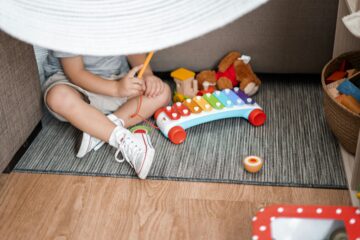In today’s society, the role of toys in a child’s development cannot be overstated. Toys are essential tools that help children learn, grow, and make sense of the world around them. They are not just a means of entertainment but crucial elements in fostering cognitive, social, emotional, and physical development. For parents of neurodiverse children, choosing the right toys is even more critical. These children often have unique developmental pathways, and the right toys can significantly aid in their learning and growth.
This blog delves into the significance of gender-neutral toys and their positive impacts, particularly for neurodiverse children. Gender-neutral toys, which are not specifically marketed towards boys or girls, provide a more inclusive and expansive play experience. They break away from the traditional gender norms that often limit children’s interests and abilities, offering them the freedom to explore a broad range of activities and skills. By moving towards gender-neutral toys, parents can foster an inclusive, diverse, and enriching environment for their children’s growth and development.
The Role of Toys in Child Development
Toys are more than just playthings; they are vital tools that contribute to a child’s overall development. Through play, children learn new skills, develop intellectually, and enhance their social and emotional well-being. Here are some specific ways in which different types of toys aid in child development:
Cognitive Development: Toys such as puzzles and building blocks help children develop problem-solving skills, spatial awareness, and logical thinking. These toys encourage children to think critically and creatively, laying a strong foundation for future learning, especially in subjects like mathematics and science.
Language and Communication: Dolls, action figures, and pretend play sets like kitchens and doctor kits encourage children to engage in imaginative play. This type of play helps in the development of language skills as children create stories, dialogues, and scenarios, enhancing their vocabulary and understanding of social interactions.
Emotional and Social Skills: Playing with dolls and stuffed animals can teach children empathy and caregiving. By taking care of a toy, children learn about nurturing and responsibility. Additionally, group play with toys can improve social skills such as sharing, cooperation, and negotiation.
Physical Development: Toys like balls, bicycles, and climbing sets promote physical activity, which is essential for developing motor skills, coordination, and overall physical health. These toys encourage children to move and be active, which is crucial for their physical development.
For neurodiverse children, these developmental benefits are particularly valuable. These children may face unique challenges in their development, and toys can provide structured yet flexible ways for them to engage with the world around them.
Understanding Gender-Neutral Toys
Gender-neutral toys are those that are not specifically marketed towards boys or girls. Historically, toys such as hula hoops, train sets, spinning tops, and rocking horses were enjoyed by children of all genders. However, in recent times, toys have become heavily gendered, with clear distinctions in colors, themes, and marketing strategies.
Gender-neutral toys reflect a breaking down of traditional gender binaries, allowing children to explore a broader spectrum of interests and activities without the constraints of outdated norms. These toys are designed to be inclusive and accessible to all children, regardless of gender. They encourage children to explore their interests freely, without being confined to stereotypical gender roles.
The Impact of Gendered Toys
Gendered toys are pervasive, with stores and online platforms often segregating toys by gender. This segregation is not just physical but also visual, with girls’ toys predominantly featuring pinks and purples and boys’ toys showcasing darker blues, blacks, and greens. This marketing strategy has significant implications:
Skill Development: Toys marketed to boys often emphasize adventure, action, and excitement, potentially fostering skills related to movement and conflict resolution. Girls’ toys, on the other hand, are more likely to focus on nurturing, creativity, and appearance. This can limit the development of a diverse set of skills in children.
Stereotypes and Inequality: These marketing practices reinforce gender stereotypes that children absorb at an early age, influencing their perceptions of appropriate roles and careers for men and women. This can contribute to gender imbalances in fields such as STEM for girls and caregiving professions for boys.
Anxiety and Bullying: Assigning gendered labels to toys can increase anxiety among children worried about playing with the “wrong” toy. This can lead to social exclusion and bullying, particularly for neurodiverse children who may already feel different.
The Benefits of Gender-Neutral Toys
Encouraging Inclusive Play: Gender-neutral toys provide an inclusive play environment where children can explore interests freely. This is especially important for neurodiverse children, who may have unique ways of interacting with their environment. Inclusive play allows these children to engage in activities that cater to their interests and developmental needs without being limited by gender norms.
Breaking Free from Stereotypes: By offering gender-neutral toys, parents can help their children avoid the limitations imposed by traditional gender roles. This freedom encourages children to pursue a wider range of activities and interests, fostering a more well-rounded development. Children can develop skills in various areas, from STEM to arts and crafts, without being influenced by gendered expectations.
Fostering Skill Development: Gender-neutral toys support the development of a broad range of skills without the influence of gender biases. This ensures that all children, regardless of gender, have equal opportunities to develop essential life skills. For neurodiverse children, this can mean finding toys that cater to their specific developmental needs, whether it’s improving motor skills, enhancing cognitive abilities, or fostering social interactions.
Challenges in Adopting Gender-Neutral Toys
Despite the clear benefits, adopting gender-neutral toys can be challenging due to entrenched marketing practices. Toys are often marketed in a way that reinforces traditional gender roles, making it difficult for parents to break free from these norms. For instance:
Marketing Influence: Toys marketed to boys often highlight action and aggression, while those for girls emphasise nurturing and creativity. This can make it hard for parents to choose toys that go against these trends. Parents may feel societal pressure to conform to these norms, even if they understand the benefits of gender-neutral toys.
Consumer Choices: Many parents feel uncomfortable buying toys that are marketed to the opposite gender, leading to missed opportunities for diverse skill development. They may also struggle to find gender-neutral toys in stores, as these toys are often less prominently displayed.
How to Move Towards Gender-Neutral Toys
Encouraging Inclusive Play: Provide children with a variety of toys that encourage different types of play, from building blocks and puzzles to dolls and pretend kitchens. This variety helps children develop a wide range of skills. Look for toys that promote creativity, critical thinking, and physical activity without being tied to a specific gender.
Breaking Free from Stereotypes: Actively seek out and purchase toys that are marketed as gender-neutral. Support brands and stores that promote inclusivity in their toy selections. By choosing toys based on their developmental benefits rather than their gender labels, parents can help their children explore a wider range of interests and abilities.
Fostering Skill Development: Pay attention to the developmental benefits of toys rather than their gender labels. Choose toys that help develop cognitive, spatial, and social skills, regardless of their traditional gender associations. Encourage children to play with toys that challenge them and help them grow in various areas.
Gender-neutral toys play a crucial role in the development of all children, especially those who are neurodiverse. By breaking away from traditional gender norms, these toys promote inclusivity, skill development, and a broader understanding of the world. Parents can support their children’s growth by choosing toys that encourage diverse interests and abilities, creating a more inclusive and enriching play environment.
By embracing gender-neutral toys, parents not only help their neurodiverse children thrive but also contribute to a more equitable and inclusive society for future generations. The move towards gender-neutral toys is a step towards breaking down barriers and allowing all children to reach their full potential, free from the constraints of outdated gender norms.
Further Reads :
https://www.lettoysbetoys.org.uk/why-it-matters
https://www.colorlandtoys.com/blog/gender-neutral-toys-and-gentle-parenting-tips



0 Comments